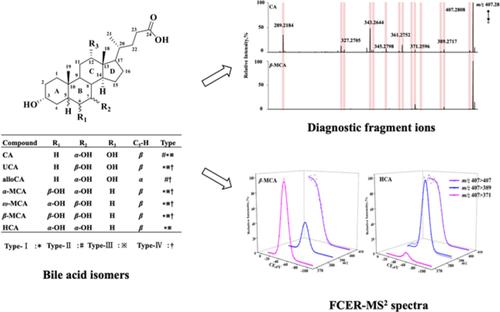当前位置:
X-MOL 学术
›
J. Chin. Chem. Soc.
›
论文详情
Our official English website, www.x-mol.net, welcomes your feedback! (Note: you will need to create a separate account there.)
Isomeric differentiation of bile acids using three‐dimensional MS2 spectrum
Journal of the Chinese Chemical Society ( IF 1.8 ) Pub Date : 2024-02-29 , DOI: 10.1002/jccs.202300424 Xiaoya Niu 1 , Yuxuan Zhou 1 , Wenhui Zhao 1 , Xiaoyun Li 1 , Luyao Ren 1 , Pengfei Tu 1 , Wenjing Liu 2 , Yuelin Song 1
Journal of the Chinese Chemical Society ( IF 1.8 ) Pub Date : 2024-02-29 , DOI: 10.1002/jccs.202300424 Xiaoya Niu 1 , Yuxuan Zhou 1 , Wenhui Zhao 1 , Xiaoyun Li 1 , Luyao Ren 1 , Pengfei Tu 1 , Wenjing Liu 2 , Yuelin Song 1
Affiliation

|
Bile acids (BAs) currently occupy the research hotspot because of their unreplaceable physiological functions as well as their unique abilities to reflect the physiopathological status. It is always challenging to characterize BAs‐submetabolome using LC–MS/MS, primarily attributing to the high‐level structural diversity. The key obstructing confirmative identification is isomeric identification because of the inherent “isomer‐blind” disadvantage of MS/MS. The isomerism styles of BAs are broadly divided into: type‐I, 5α ‐H and 5β ‐H epimers; type‐II, α ‐OH and β ‐OH epimers; type‐III, C‐OH positional isomers; and type‐IV, hybrid isomers bearing two or more isomerism fashions. Herein, we aim to comprehensively pursue isomer‐selective clues for BAs through constructing three‐dimensional MS2 (3D‐MS2 ) spectrum that was accomplished by fortifying energy‐resolved MS (ER‐MS) program as the new dimension. The breakdown graphs of primary MS2 spectral signals composed of 3D‐MS2 spectrum namely full collision energy ramp (FCER)‐MS2 spectrum for each BA species after appropriate normalization, and seven isomeric BAs covering all isomerism styles were utilized as representative cases. After recording MS2 spectra with progressive CE levels, differences were observed for their FCER‐MS2 spectra. Diagnostic fragment ions (DFIs) occurred within type‐I, type‐II, type‐III or type‐IV isomers, and noteworthily, 2.02 Da neutral loss discriminated BAs containing cis ‐6,7‐diol and trans ‐6,7‐diol functional groups. Notably, the features such as the maximal relative ion intensity (RIImax ) and optimal CE (OCE) enabled isomeric differentiation for all types, even type‐II and type‐III isomers. Above all, it is feasible to acquire in‐depth isomer‐selective MS/MS clues for BAs using FCER‐MS2 spectrum, regardless of the isomerism manner.
中文翻译:

使用三维 MS2 谱图区分胆汁酸的异构体
胆汁酸(BAs)因其不可替代的生理功能以及反映病理生理状态的独特能力而成为目前的研究热点。使用 LC-MS/MS 表征 BAs 亚代谢组始终具有挑战性,这主要归因于高水平的结构多样性。由于 MS/MS 固有的“异构体盲”缺点,异构体鉴定是阻碍确认性鉴定的关键。BA的异构类型大致分为:I型、5型α ‐H 和 5β ‐H 差向异构体;II型,α ‐OH 和β ‐OH差向异构体;III型,C-OH位置异构体;IV 型,具有两种或多种异构形式的混合异构体。在此,我们的目标是通过构建三维 MS 来全面寻找 BA 的异构体选择性线索2 (3D-MS2 )光谱是通过强化能量分辨质谱(ER-MS)程序作为新维度而实现的。原发性MS的分解图2 由 3D-MS 组成的光谱信号2 谱即全碰撞能量斜坡 (FCER)-MS2 适当归一化后每个 BA 物种的光谱,并使用涵盖所有异构类型的七种异构 BA 作为代表性案例。记录 MS 后2 随着 CE 水平的提高,观察到 FCER-MS 的差异2 光谱。诊断碎片离子 (DFI) 出现在 I 型、II 型、III 型或 IV 型异构体中,值得注意的是,2.02 Da 中性丢失可区分 BAs 包含顺式 ‐6,7-二醇和反式 ‐6,7-二醇官能团。值得注意的是,诸如最大相对离子强度 (RII最大限度 )和最佳 CE (OCE) 可以实现所有类型的异构体分化,甚至是 II 型和 III 型异构体。最重要的是,使用 FCER-MS 获得 BA 的深入异构体选择性 MS/MS 线索是可行的2 光谱,无论异构方式如何。
更新日期:2024-02-29
中文翻译:

使用三维 MS2 谱图区分胆汁酸的异构体
胆汁酸(BAs)因其不可替代的生理功能以及反映病理生理状态的独特能力而成为目前的研究热点。使用 LC-MS/MS 表征 BAs 亚代谢组始终具有挑战性,这主要归因于高水平的结构多样性。由于 MS/MS 固有的“异构体盲”缺点,异构体鉴定是阻碍确认性鉴定的关键。BA的异构类型大致分为:I型、5型



























 京公网安备 11010802027423号
京公网安备 11010802027423号